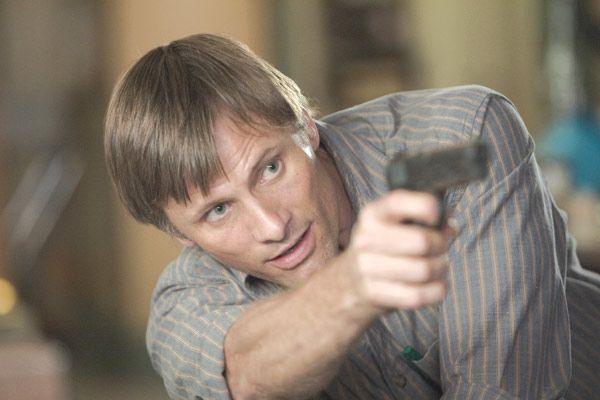Quick Analysis: A History of Violence
A History of Violence was my favorite film of 2005. The following is a quick analysis of some of the film's essential characteristics.
A History of Violence may be the greatest American movie ever made by a Canadian. Its director, David Cronenberg, is a native of Toronto, and much of the film was shot in our great neighbor to the north. However, with its small-town setting and everyman hero, the film exudes Americana like a Norman Rockwell painting. It explores America’s fascination with violence and reinvention of the self with more depth and clarity than any film released in the past five years.
Released in September of 2005 and starring Viggo Mortensen and Maria Bello, A History of Violence tells the story of Tom Stall, family man and owner of a diner in the fictional town of Millbrook, Indiana. Essentially, Tom has achieved the American dream: a beautiful wife and two children, a large farmhouse complete with white picket fence, and a successful business. When two thugs threaten his life, Tom unleashes a fury of violence that renders him a national hero. However, when more thugs show up claiming to be Tom’s former associates, trust disintegrates into violence as it becomes less and less clear who Tom actually is. The film centers on the Stall family’s reaction to the violence and new questions of their father’s identity.
In any other hands, this film might have been cheap stock for shock value and gore effects. However, Cronenberg’s master touch allows the film to rise beyond its violent face value. It becomes a brooding expose on the American concept of self-made identity, as well as our country’s obsession with violence. The films country setting and average man set up root the film in the tradition of the American dream. The unraveling of the lead’s identity and punctuated portrayals of violence act to dismantle that dream, examining it from the very core. The end result is not only unsettling, but also uproarious – we are given the full range view of Americana, from its beauty to its blemishes. 
The film plays heavily on the idea of deception and identity. Shot almost exclusively in 27mm (wide angle lens), Cronenberg uses wide compositions to visualize the idea of deception and fragmented viewpoints. In many shots, we are given a wide viewpoint of a door, a hallway, or scene, yet something within that space remains hidden. It might be physical, a character cropped by the lens, or metaphorical, the connecting bond between family members. For example, in the final scene in which the Stalls reunite for dinner, Cronenberg’s camera shifts along a jagged edge, showing each family members reaction, but rarely allowing any two to cross, let alone the family be shown united as a whole. Plot wise, the film explores the idea of the self-made man; namely, that a man can escape his past and become someone new in America. The idea of self-development is crucial to the American dream, and though the film doesn’t quite debunk it, it certainly raises questions as to whether a man can effectively escape his former past, especially one stooped in violence.
Violence is the key word in this film. It is what jump starts the chain of events and is effectively what the main protagonist is trying to escape. However, Cronenberg’s reading of violence within the film is multilayered, and functions as a mirror to our own culture’s understanding and acceptance of violence. Acts of violence are scattered throughout the film, punctuated to a distinct rhythm. They come and go as scenes of violence often do in real life, occurring quickly and without warning, then dissipating with only the bloody aftermath remaining. Violence functions as a comedic element (the scene in which Tom kills his brother), as action-entertainment (the scene in the diner), and as horror (the scene in front of the Stall home). Violence is lauded and praised, such as Tom’s ‘heroic’ actions in the diner, and well as condemned and rejected, such as Tom’s ‘negative’ actions in front of the Stall home. Most importantly, violence is passed from generation to generation, with Tom’s eldest son continuing the tradition by using a shotgun to save his father. Later, when Tom throw’s his gun into a lake to wash himself clean, it’s hard not picture that lake as a cesspool teeming with life, and that gun simply laying there, waiting for some other life-form to pick it up and continue where it left off.
What Cronenberg is doing in this film is exploring violence from multiple angles the same way our society accepts violence in multiple ways. He allows room for each and every possible reaction to the violence; perhaps most effectively when the grotesque leads to humor, which feels most unsettling. More interestingly, he never allows his audience a full view of the violent act, choosing to cut away, or rely on close ups or distance shots to portray the action. Rather, he lingers on the consequences of the violence, in both metaphysical (the dissolution of the family) and physical (extreme after-the-fact gore shots, dead bodies pulsating, oozing blood) terms. The film passes no judgment on America’s fascination with violence and ultimately leaves it’s question – can the American dream remain, despite the horrors of bloodshed? – unanswered. However, Cronenberg calls for a better understanding of the effects of violence and the way our society reacts to violence. The final product is so unabashedly American, it’s hard to believe a Canadian was involved at all.

No comments:
Post a Comment